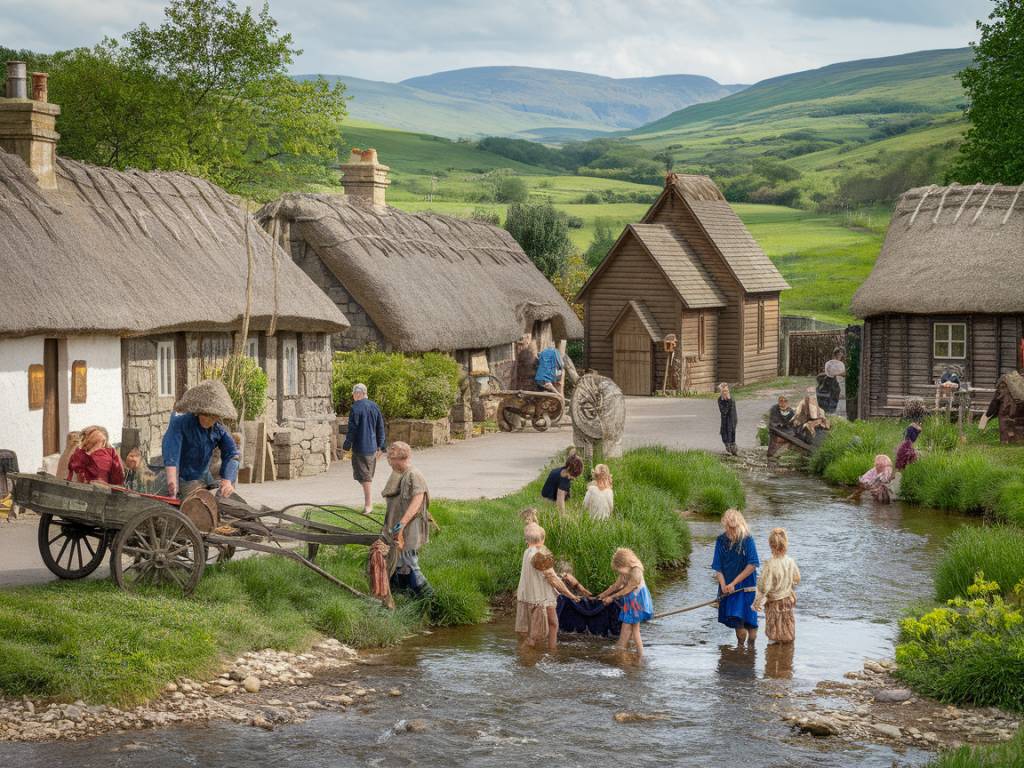Life in a Medieval Welsh Village: An Invitation to Step Back in Time
Have you ever wondered what life was like in a medieval Welsh village? What did people eat? How did they work, celebrate, and survive the daily grind? In this journey through time, let’s explore the customs, daily routines, and traditions that shaped the lives of medieval Welsh villagers. Prepare to step into a world without modern conveniences, where community, lore, and resourcefulness reigned supreme.
The Heart of the Village: A Community-Built Way of Life
In medieval Wales, villages were small but vibrant, often tight-knit communities where everyone played a role. Picture a cluster of modest homes, typically constructed with wattle-and-daub walls and thatched roofs. These dwellings weren’t luxurious by any stretch, yet they served as cozy sanctuaries against Wales’ famously unpredictable weather.
The heart of the village was usually the tyddyn, or the central homestead, where livestock such as pigs, cows, and chickens roamed freely. This humble hub wasn’t merely a place to live; it was a space for working, storing food, and often bonding over fireside tales. Isn’t it fascinating to think how such simplicity could foster such a strong sense of belonging?
Long Days, Honest Work
Daily life revolved around labor—backbreaking yet essential to survival. For most, farming was the cornerstone of existence. Crops like oats, barley, and rye were staples, supplemented by vegetables such as leeks—a quintessentially Welsh ingredient that’s still beloved today.
Men typically plowed the fields while women tended to household gardens, prepared meals, and managed livestock. Children, far from idle, contributed wherever they could, whether by fetching water, feeding animals, or learning life’s skills on the job. Talk about multitasking!
Beyond agriculture, craftsmen and women played vital roles. Blacksmiths forged tools and horseshoes, while weavers and spinners produced fabrics for clothing. Every small village was its own ecosystem of skills, tightly interwoven to meet the needs of its people.
A Feast of Simplicity
What did medieval Welsh villagers eat? Their diet was far from extravagant but undeniably wholesome. Bread was a mainstay, often accompanied by cheese, butter, and stews. Meat was a treat reserved for special occasions, with lamb and mutton making occasional appearances alongside preserved fish.
Foraging provided additional flavors and nutrients. Berries, wild herbs, and nuts were commonly gathered to enrich meals. Honey, nature’s sweetener, played a notable role, whether drizzled onto bread or fermented into mead—a drink often enjoyed during festivals.
Can you smell the smoky richness of a pottage simmering over an open flame? Though modest, these meals were made with care and rooted in a connection to the land that nourished them.
Traditions and Celebrations: Bringing the Village to Life
Life wasn’t all work. Important moments were marked by deeply rooted traditions that often combined elements of Celtic paganism and Christian influence. Seasonal festivals like Calan Mai (May Day) and Calan Gaeaf (the precursor to Halloween) celebrated the turning of the seasons with feasts, music, and dancing.
Marriage ceremonies were joyful village-wide events, while funerals provided moments of solemn unity. Oral storytelling and music were cherished communal activities. Sitting by the fire, villagers would recount ancient folklore, pass down family histories, and play instruments like the harp—a cornerstone of Welsh musical heritage.
These gatherings served as essential pauses in the rhythm of daily labor, reinforcing bonds and keeping the cultural fabric vibrant. Who wouldn’t smile at the thought of neighbors coming together for a night of song and laughter after a long day of tilling the soil?
Challenges and Perseverance
Life in a medieval Welsh village wasn’t without its challenges. Harsh winters tested resilience, while diseases, poor sanitation, and occasional skirmishes added layers of uncertainty. Yet the villagers’ solidarity often provided a safety net. They shared resources, supported one another in difficult times, and clung to their faith and traditions as a means of facing adversity.
Their landscape—rocky hills, rolling meadows, and misty valleys—was both a blessing and a hurdle. It offered natural resources like timber and stone but demanded ingenuity in farming and survival tactics.
Lingering Echoes in Modern Wales
Though centuries have passed, echoes of medieval village life can still be found in Welsh culture today. Many festivals have evolved into modern celebrations, while traditional recipes, music, and stories continue to be cherished. Historic landmarks, such as village churches and ruins of medieval homes, stand as silent witnesses to a way of life long gone but not forgotten.
Next time you wander through the Welsh countryside, take a moment to imagine the rich history beneath your feet. Who knows? You might even picture yourself sharing stories around a medieval hearth, a bowl of pottage in hand, as the harpist plays in the background.

